Multi-Criteria Plant Clustering for Carbon-Centric Urban Forestry: Enhancing Sequestration Potential Through Adaptive Species Selection in the Zhengzhou Metropolitan Area, China
Abstract
1. Introduction
2. Materials and Methods
2.1. Study Area
2.2. Data Collection
2.3. Methods
2.3.1. Calculation of CSE Capacity of Trees
2.3.2. Calculation of CSE Capacity of Shrubs
2.3.3. Analysis of Differences in CSE Capacity Between Cities and Green Spaces
2.3.4. Extraction of Evaluation Criteria Based on Plant Application Scenarios
2.3.5. Clustering Analysis
2.3.6. Simulation of CSE Capacity Enhancement Based on Tree Regeneration
3. Results
3.1. Overview of Urban Trees and Their CSE Capacity
3.2. Clustering Results of Trees and Shrubs
3.3. Impact of Trees Renewal on Enhancing CES Capacity
4. Discussion
4.1. Regional Disparities and Comparative Analysis of CSE Capacity in UGS of the ZMA
4.2. Selection of UGS Plant Species Based on CSE Capacity
4.3. Optimizing CSE Capacity Through Plants Selection
5. Conclusions
Supplementary Materials
Author Contributions
Funding
Data Availability Statement
Conflicts of Interest
Abbreviations
| CS | carbon storage (kg C) |
| CSE | carbon sequestration (kg C y−1) |
| CSE capacity | carbon sequestration capacity is an aggregate of carbon stocks and sequestration, representing no specific unit of their ability to fix carbon. |
| CS density | carbon storage density (kg C m−2) |
| CSE density | carbon sequestration density (kg C y−1 m−2) |
| CSE per unit area | carbon sequestration per unit area (g C y−1 m−2) |
References
- World Development Indicators | Data Catalog. Available online: https://datacatalog.worldbank.org/search/dataset/0037712/World-Development-Indicators (accessed on 13 January 2025).
- Zhang, C. A Novel Analysis of Consumption-Based Carbon Footprints in China: Unpacking the Effects of Urban Settlement and Rural-to-Urban Migration. Glob. Environ. Change 2016, 39, 285–293. [Google Scholar] [CrossRef]
- Feng, R.; Liu, S.; Wang, F.; Wang, K.; Gao, P.; Xu, L. Quantifying the Environmental Synergistic Effect of Cooling-Air Purification-Carbon Sequestration from Urban Forest in China. J. Clean. Prod. 2024, 448, 141514. [Google Scholar] [CrossRef]
- Goodwin, S.; Olazabal, M.; Castro, A.J.; Pascual, U. Global Mapping of Urban Nature-Based Solutions for Climate Change Adaptation. Nat. Sustain. 2023, 6, 458–469. [Google Scholar] [CrossRef]
- Heath, L.S.; Smith, J.E.; Skog, K.E.; Nowak, D.J.; Woodall, C.W. Managed Forest Carbon Estimates for the US Greenhouse Gas Inventory, 1990–2008. J. For. 2011, 109, 167–173. [Google Scholar]
- Churkina, G. The Role of Urbanization in the Global Carbon Cycle. Front. Ecol. Evol. 2016, 3, 144. [Google Scholar] [CrossRef]
- Jia, X.; Han, H.; Feng, Y.; Song, P.; He, R.; Liu, Y.; Wang, P.; Zhang, K.; Du, C.; Ge, S.; et al. Scale-Dependent and Driving Relationships between Spatial Features and Carbon Storage and Sequestration in an Urban Park of Zhengzhou, China. Sci. Total Environ. 2023, 894, 164916. [Google Scholar] [CrossRef]
- Shafique, M.; Xue, X.; Luo, X. An Overview of Carbon Sequestration of Green Roofs in Urban Areas. Urban For. Urban Green. 2020, 47, 126515. [Google Scholar] [CrossRef]
- Zhao, D.; Cai, J.; Xu, Y.; Liu, Y.; Yao, M. Carbon Sinks in Urban Public Green Spaces under Carbon Neutrality: A Bibliometric Analysis and Systematic Literature Review. Urban For. Urban Green. 2023, 86, 128037. [Google Scholar] [CrossRef]
- Le Noë, J.; Matej, S.; Magerl, A.; Bhan, M.; Erb, K.-H.; Gingrich, S. Modeling and Empirical Validation of Long-Term Carbon Sequestration in Forests (France, 1850–2015). Glob. Change Biol. 2020, 26, 2421–2434. [Google Scholar] [CrossRef]
- Dahlhausen, J.; Rötzer, T.; Biber, P.; Uhl, E.; Pretzsch, H. Urban Climate Modifies Tree Growth in Berlin. Int. J. Biometeorol. 2018, 62, 795–808. [Google Scholar] [CrossRef]
- McPherson, E.G.; Simpson, J.R. Carbon Dioxide Reduction through Urban Forestry: Guidelines for Professional and Volunteer Tree Planters; Gen. Tech. Rep. PSW-GTR-171; U.S. Department of Agriculture, Forest Service, Pacific Southwest Research Station: Albany, CA, USA, 2022; 237p. [Google Scholar] [CrossRef]
- Moss, J.L.; Doick, K.J.; Smith, S.T.; Shahrestani, M. Influence of evaporative cooling by urban forests on cooling demand in cities. Urban For. Urban Green. 2019, 37, 65–73. [Google Scholar] [CrossRef]
- Nowak, D.J.; Hirabayashi, S.; Doyle, M.; McGovern, M.; Pasher, J. Air Pollution Removal by Urban Forests in Canada and Its Effect on Air Quality and Human Health. Urban For. Urban Green. 2018, 29, 40–48. [Google Scholar] [CrossRef]
- Chen, W.; Wang, G.; Zeng, J. Impact of Urban Expansion on Ecosystem Services in Different Urban Agglomerations in China. Int. J. Environ. Sci. Technol. 2023, 20, 12625–12644. [Google Scholar] [CrossRef]
- Liu, Q.; Qiao, J.; Li, M.; Dun, Y.; Zhu, X.; Ji, X. Spatiotemporal Evolution of Ecological Environmental Quality and Its Dynamic Relationships with Landscape Pattern in the Zhengzhou Metropolitan Area: A Perspective Based on Nonlinear Effects and Spatiotemporal Heterogeneity. J. Clean. Prod. 2024, 480, 144102. [Google Scholar] [CrossRef]
- Li, Y.; Qiao, X.; Wang, Y.; Liu, L. Spatiotemporal Patterns and Influencing Factors of Remotely Sensed Regional Heat Islands from 2001 to 2020 in Zhengzhou Metropolitan Area. Ecol. Indic. 2023, 155, 111026. [Google Scholar] [CrossRef]
- Qiao, X.; Li, Y.; Wang, Y.; Liu, L.; Zhao, S. The Influence of Climate and Human Factors on a Regional Heat Island in the Zhengzhou Metropolitan Area, China. Environ. Res. 2024, 249, 118331. [Google Scholar] [CrossRef]
- Alonzo, M.; McFadden, J.P.; Nowak, D.J.; Roberts, D.A. Mapping Urban Forest Structure and Function Using Hyperspectral Imagery and Lidar Data. Urban For. Urban Green. 2016, 17, 135–147. [Google Scholar] [CrossRef]
- Sun, W.; Liu, X. Review on Carbon Storage Estimation of Forest Ecosystem and Applications in China. For. Ecosyst. 2019, 7, 4. [Google Scholar] [CrossRef]
- Conti, G.; Gorné, L.D.; Zeballos, S.R.; Lipoma, M.L.; Gatica, G.; Kowaljow, E.; Whitworth-Hulse, J.I.; Cuchietti, A.; Poca, M.; Pestoni, S.; et al. Developing Allometric Models to Predict the Individual Aboveground Biomass of Shrubs Worldwide. Glob. Ecol. Biogeogr. 2019, 28, 961–975. [Google Scholar] [CrossRef]
- Flora of China. Available online: https://www.iplant.cn/frps2019/zongl (accessed on 2 March 2025).
- Flora of Henan. Available online: https://cfh.ac.cn/BioBook/HNFlora/1/1.html (accessed on 2 March 2025).
- Saaty, R.W. The Analytic Hierarchy Process—What It Is and How It Is Used. Math. Model. 1987, 9, 161–176. [Google Scholar] [CrossRef]
- Roman, L.A.; Battles, J.J.; McBride, J.R. The Balance of Planting and Mortality in a Street Tree Population. Urban Ecosyst. 2014, 17, 387–404. [Google Scholar] [CrossRef]
- Weather Spark. Available online: https://worldweather.wmo.int/zh/apps.html (accessed on 4 March 2025).
- McPherson, E.G.; Xiao, Q.; Aguaron, E. A New Approach to Quantify and Map Carbon Stored, Sequestered and Emissions Avoided by Urban Forests. Landsc. Urban Plan. 2013, 120, 70–84. [Google Scholar] [CrossRef]
- Chen, W.Y. The Role of Urban Green Infrastructure in Offsetting Carbon Emissions in 35 Major Chinese Cities: A Nationwide Estimate. Cities 2015, 44, 112–120. [Google Scholar] [CrossRef]
- Currie, W.S.; Kiger, S.; Nassauer, J.I.; Hutchins, M.; Marshall, L.L.; Brown, D.G.; Riolo, R.L.; Robinson, D.T.; Hart, S.K. Multi-Scale Heterogeneity in Vegetation and Soil Carbon in Exurban Residential Land of Southeastern Michigan, USA. Ecol. Appl. 2016, 26, 1421–1436. [Google Scholar] [CrossRef]
- Nowak, D.J.; Greenfield, E.J.; Hoehn, R.E.; Lapoint, E. Carbon Storage and Sequestration by Trees in Urban and Community Areas of the United States. Environ. Pollut. 2013, 178, 229–236. [Google Scholar] [CrossRef]
- Timilsina, N.; Staudhammer, C.L.; Escobedo, F.J.; Lawrence, A. Tree Biomass, Wood Waste Yield, and Carbon Storage Changes in an Urban Forest. Landsc. Urban Plan. 2014, 127, 18–27. [Google Scholar] [CrossRef]
- Fan, L.; Cai, T.; Wen, Q.; Han, J.; Wang, S.; Wang, J.; Yin, C. Scenario Simulation of Land Use Change and Carbon Storage Response in Henan Province, China: 1990–2050. Ecol. Indic. 2023, 154, 110660. [Google Scholar] [CrossRef]
- Song, X.; Yang, S.; Shao, L.; Fan, J.; Liu, Y. PM10 Mass Concentration, Chemical Composition, and Sources in the Typical Coal-Dominated Industrial City of Pingdingshan, China. Sci. Total Environ. 2016, 571, 1155–1163. [Google Scholar] [CrossRef]
- Zhao, Y.; Jiao, L. Resources Development and Tourism Environmental Carrying Capacity of Ecotourism Industry in Pingdingshan City, China. Ecol. Process. 2019, 8, 7. [Google Scholar] [CrossRef]
- Min, M.; Zhao, H.; Chen, M. Spatio-Temporal Evolution Analysis of the Urban Heat Island: A Case Study of Zhengzhou City, China. Sustainability 2018, 10, 1992. [Google Scholar] [CrossRef]
- Besnard, S.; Santoro, M.; Cartus, O.; Fan, N.; Linscheid, N.; Nair, R.; Weber, U.; Koirala, S. Global Sensitivities of Forest Carbon Changes to Environmental Conditions. Glob. Change Biol. 2021, 27, 6467–6483. [Google Scholar] [CrossRef] [PubMed]
- Sun, Y.; Xie, S.; Zhao, S. Valuing Urban Green Spaces in Mitigating Climate Change: A City-wide Estimate of Aboveground Carbon Stored in Urban Green Spaces of China’s Capital. Glob. Change Biol. 2019, 25, 1717–1732. [Google Scholar] [CrossRef] [PubMed]
- Wang, F.; Guo, H.; Zhang, Q.; Yu, Q.; Xu, C.; Qiu, S. Optimizing Ecological Spatial Network Topology for Enhanced Carbon Sequestration in the Ecologically Sensitive Middle Reaches of the Yellow River, China. Remote Sens. 2023, 15, 2308. [Google Scholar] [CrossRef]
- Chen, Y.; Wu, B.; Dong, C.; Qi, Y. Using Machine Learning to Assess Site Suitability for Afforestation with Particular Species. Forests 2019, 10, 739. [Google Scholar] [CrossRef]
- Coelho, M.C.M.; Gabriel, R.; Ah-Peng, C. Characterizing and Quantifying Water Content in 14 Species of Bryophytes Present in Azorean Native Vegetation. Diversity 2023, 15, 295. [Google Scholar] [CrossRef]
- Asplund, M.E.; Dahl, M.; Ismail, R.; Arias-Ortiz, A.; Deyanova, D.; Franco, J.N.; Hammar, L.M.; Hoamby, A.I.; Linderholm, H.W.; Lyimo, L.D.; et al. Dynamics and Fate of Blue Carbon in a Mangrove–Seagrass Seascape: Influence of Landscape Configuration and Land-Use Change. Landsc. Ecol. 2021, 36, 1489–1509. [Google Scholar] [CrossRef]
- Dong, H.; Chen, Y.; Huang, X.; Cheng, S. Multi-Scenario Simulation of Spatial Structure and Carbon Sequestration Evaluation in Residential Green Space. Ecol. Indic. 2023, 154, 110902. [Google Scholar] [CrossRef]
- Liu, Y.; Yang, Q.; Duan, L. Adjusting the Structure Combinations of Plant Communities in Urban Greenspace Reduced the Maintenance Energy Consumption and GHG Emissions. J. Environ. Eng. Landsc. Manag. 2018, 26, 261–274. [Google Scholar] [CrossRef]
- Hou, D.; Al-Tabbaa, A.; O’Connor, D.; Hu, Q.; Zhu, Y.-G.; Wang, L.; Kirkwood, N.; Ok, Y.S.; Tsang, D.C.W.; Bolan, N.S.; et al. Sustainable Remediation and Redevelopment of Brownfield Sites. Nat. Rev. Earth Environ. 2023, 4, 271–286. [Google Scholar] [CrossRef]
- Song, Y.; Kirkwood, N.; Maksimovic, C.; Zhen, X.; O’Connor, D.; Jin, Y.; Hou, D. Nature Based Solutions for Contaminated Land Remediation and Brownfield Redevelopment in Cities: A Review. Sci. Total Environ. 2019, 663, 568–579. [Google Scholar] [CrossRef]
- Karimi, J.D.; Corstanje, R.; Harris, J.A. Bundling Ecosystem Services at a High Resolution in the UK: Trade-Offs and Synergies in Urban Landscapes. Landsc. Ecol. 2021, 36, 1817–1835. [Google Scholar] [CrossRef]
- Kronenberg, J.; Andersson, E.; Barton, D.N.; Borgström, S.; Langemeyer, J.; Björklund, T.; Haase, D.; Kennedy, C.; Koprowska, K.; Łaszkiewicz, E.; et al. The Thorny Path toward Greening: Unintended Consequences, Trade-Offs, and Constraints in Green and Blue Infrastructure Planning, Implementation, and Management. Ecol. Soc. 2021, 26, art36. [Google Scholar] [CrossRef]
- Barbierato, E.; Bernetti, I.; Capecchi, I.; Saragosa, C. Integrating Remote Sensing and Street View Images to Quantify Urban Forest Ecosystem Services. Remote Sens. 2020, 12, 329. [Google Scholar] [CrossRef]
- Jiang, Y.; Sun, Y.; Liu, Y.; Li, X. Exploring the Correlation between Waterbodies, Green Space Morphology, and Carbon Dioxide Concentration Distributions in an Urban Waterfront Green Space: A Simulation Study Based on the Carbon Cycle. Sustain. Cities Soc. 2023, 98, 104831. [Google Scholar] [CrossRef]
- Dong, L.; Wang, Y.; Ai, L.; Cheng, X.; Luo, Y. A review of research methods for accounting urban green space carbon sinks and exploration of new approaches. Front. Environ. Sci. 2024, 12, 1350185. [Google Scholar] [CrossRef]
- Chen, D.; Neumann, K.; Friedel, S.; Kilian, B.; Chen, M.; Altmann, T.; Klukas, C. Dissecting the Phenotypic Components of Crop Plant Growth and Drought Responses Based on High-Throughput Image Analysis. Plant Cell 2014, 26, 4636–4655. [Google Scholar] [CrossRef]
- Dybala, K.E.; Steger, K.; Walsh, R.; Gardali, T.; Seavy, N.E. Optimizing carbon storage and biodiversity co-benefits in reforested riparian zones. J. Appl. Ecol. 2018, 56, 343–353. [Google Scholar] [CrossRef]
- Calvo, L.; Huerta, S.; Marcos, E.; Calvo-Fernández, J.; Taboada, Á. The role of prescribed fire in the provision of regulating ecosystem services of Spanish heathlands. Ecol. Quest. 2015, 21, 71–73. [Google Scholar] [CrossRef]
- Zhang, J.; Li, S.; Sun, X.; Tong, J.; Fu, Z.F.; Li, J. Sustainability of Urban Soil Management: Analysis of Soil Physicochemical Properties and Bacterial Community Structure under Different Green Space Types. Sustainability 2019, 11, 1395. [Google Scholar] [CrossRef]
- Han, J.; Dong, Y.; Ren, Z.; Wang, C.; Jia, G.; Zhang, P.; Guo, Y. Remarkable Effects of Urbanization on Forest Landscape Multifunctionality in Urban Peripheries: Evidence from Liaoyuan City in Northeast China. Forests 2021, 12, 1779. [Google Scholar] [CrossRef]
- Yu, Z.; Yang, G.; Zuo, S.; Jørgensen, G.; Koga, M.; Vejre, H. Critical review on the cooling effect of urban blue-green space: A threshold-size perspective. Urban For. Urban Green. 2020, 49, 126630. [Google Scholar] [CrossRef]
- Gao, Z.; Song, K.; Pan, Y.; Malkinson, D.; Zhang, X.; Jia, B.; Tiyuan, X.; Guo, X.; Liang, H.; Huang, S.; et al. Drivers of spontaneous plant richness patterns in urban green space within a biodiversity hotspot. Urban For. Urban Green. 2021, 61, 127098. [Google Scholar] [CrossRef]
- Tong, S.; Wang, W.; Chen, J.; Xu, C.-Y.; Sato, H.; Wang, G. Impact of changes in climate and CO2 on the carbon storage potential of vegetation under limited water availability using SEIB-DGVM version 3.02. Geosci. Model Dev. 2022, 15, 7075–7098. [Google Scholar] [CrossRef]
- Lv, H.; Wang, W.; He, X.; Wei, C.; Lu, X.; Zhang, B.; Zhou, W. Association of urban forest landscape characteristics with biomass and soil carbon stocks in Harbin City, Northeastern China. PeerJ 2018, 6, e5825. [Google Scholar] [CrossRef]
- Huo, Z.; Liu, G.; Yan, N.; Li, H.; Shah, A.M.; Chen, Y.; Zhao, B.; Lu, Z.; Ghisellini, P. Estimating the contribution of community landscape construction to urban carbon neutrality: Methodology and database construction. Environ. Res. Lett. 2023, 18, 104035. [Google Scholar] [CrossRef]
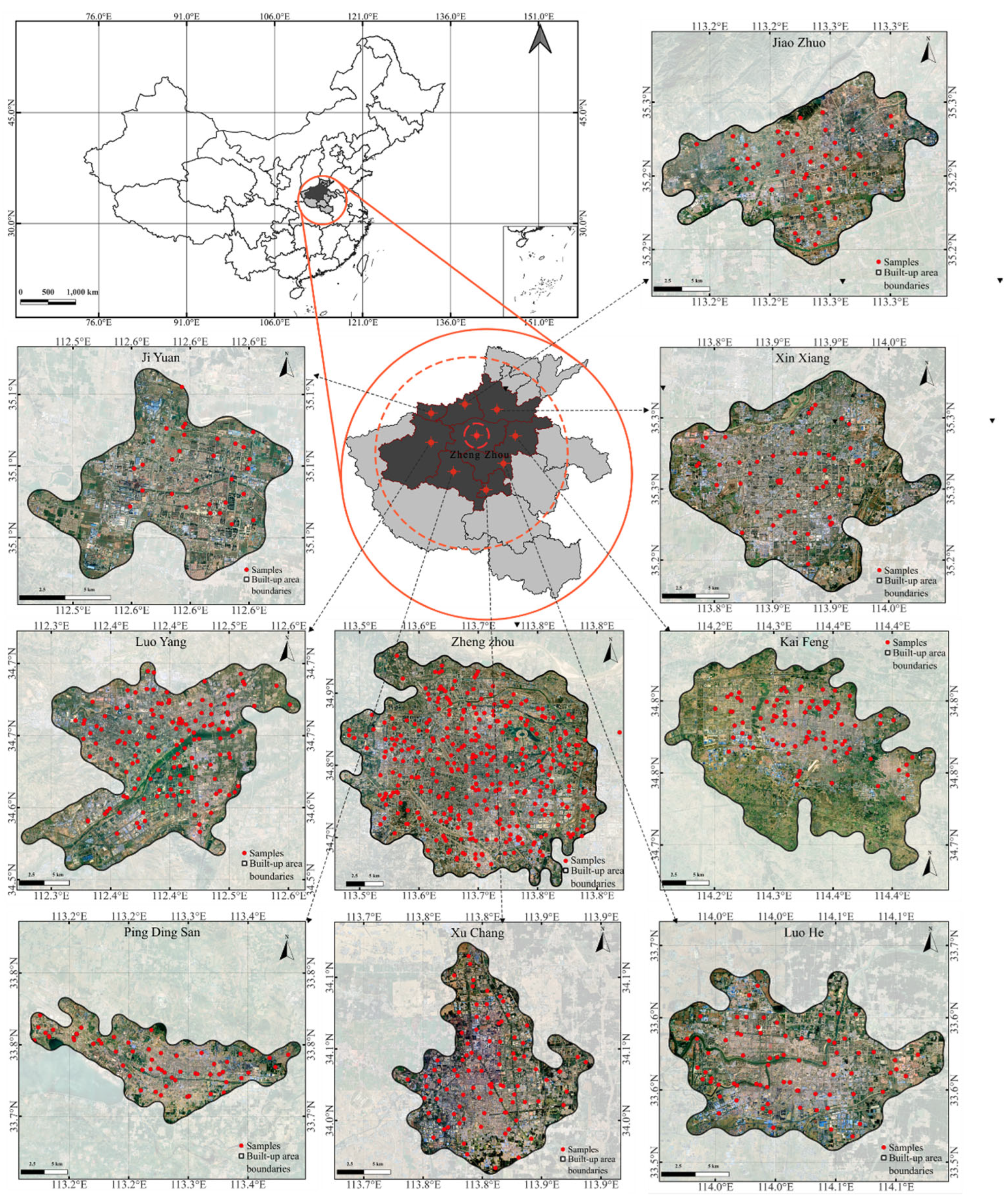
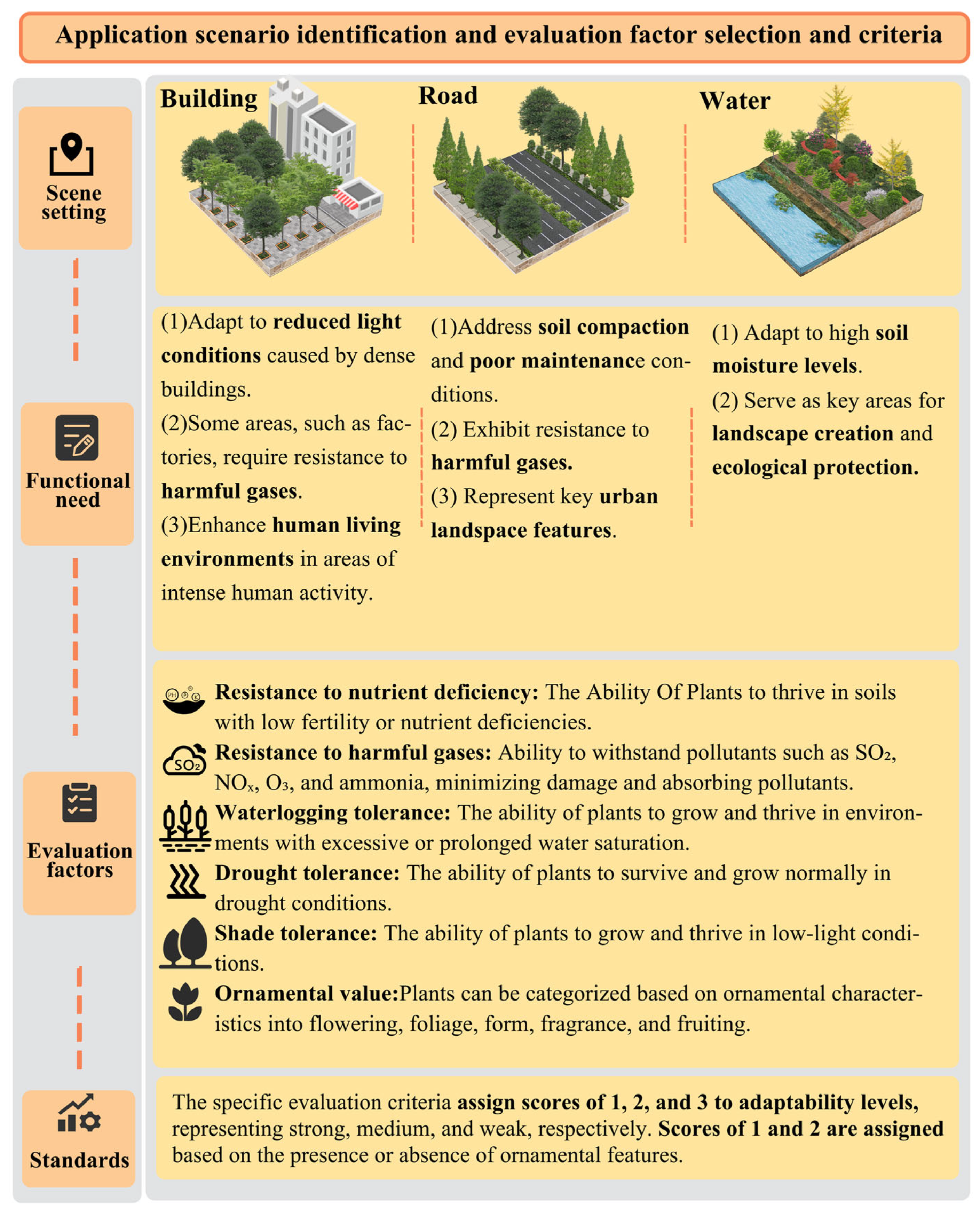
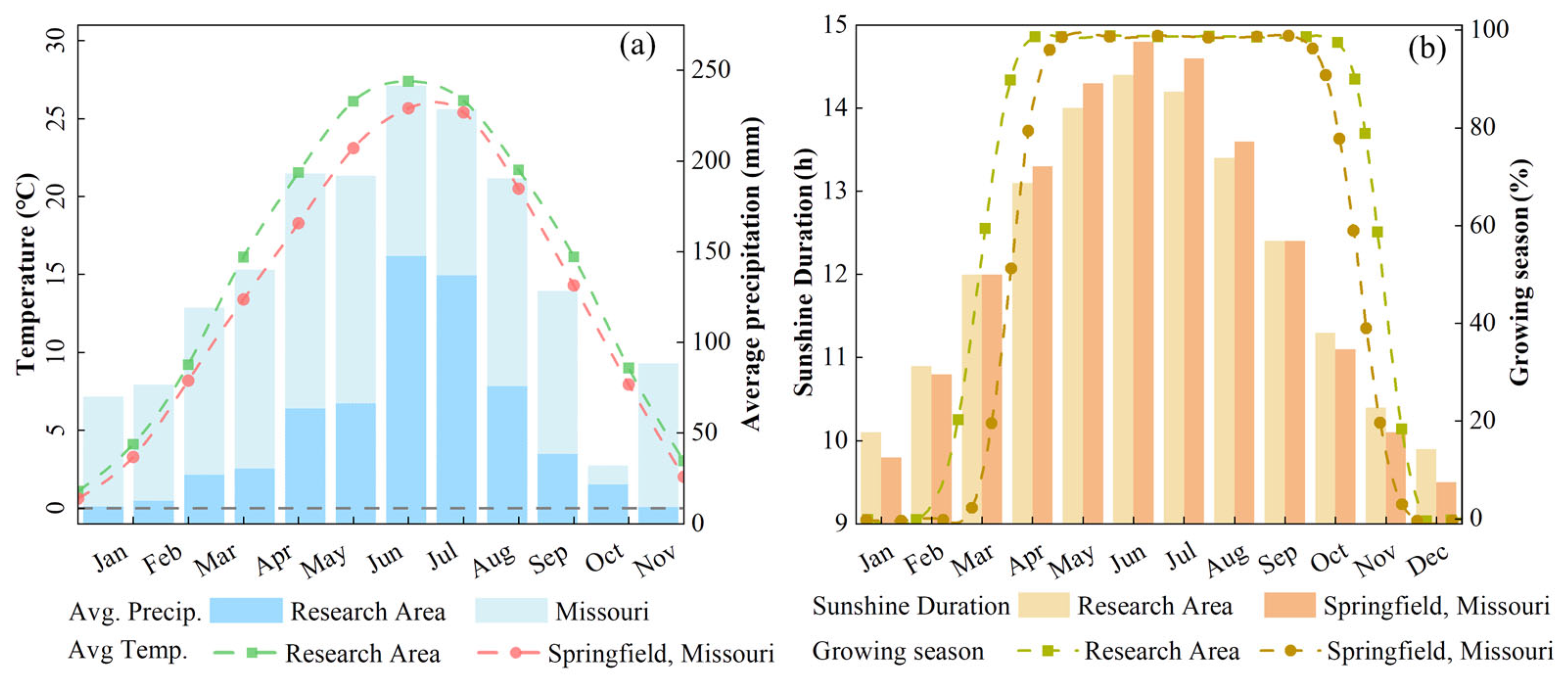
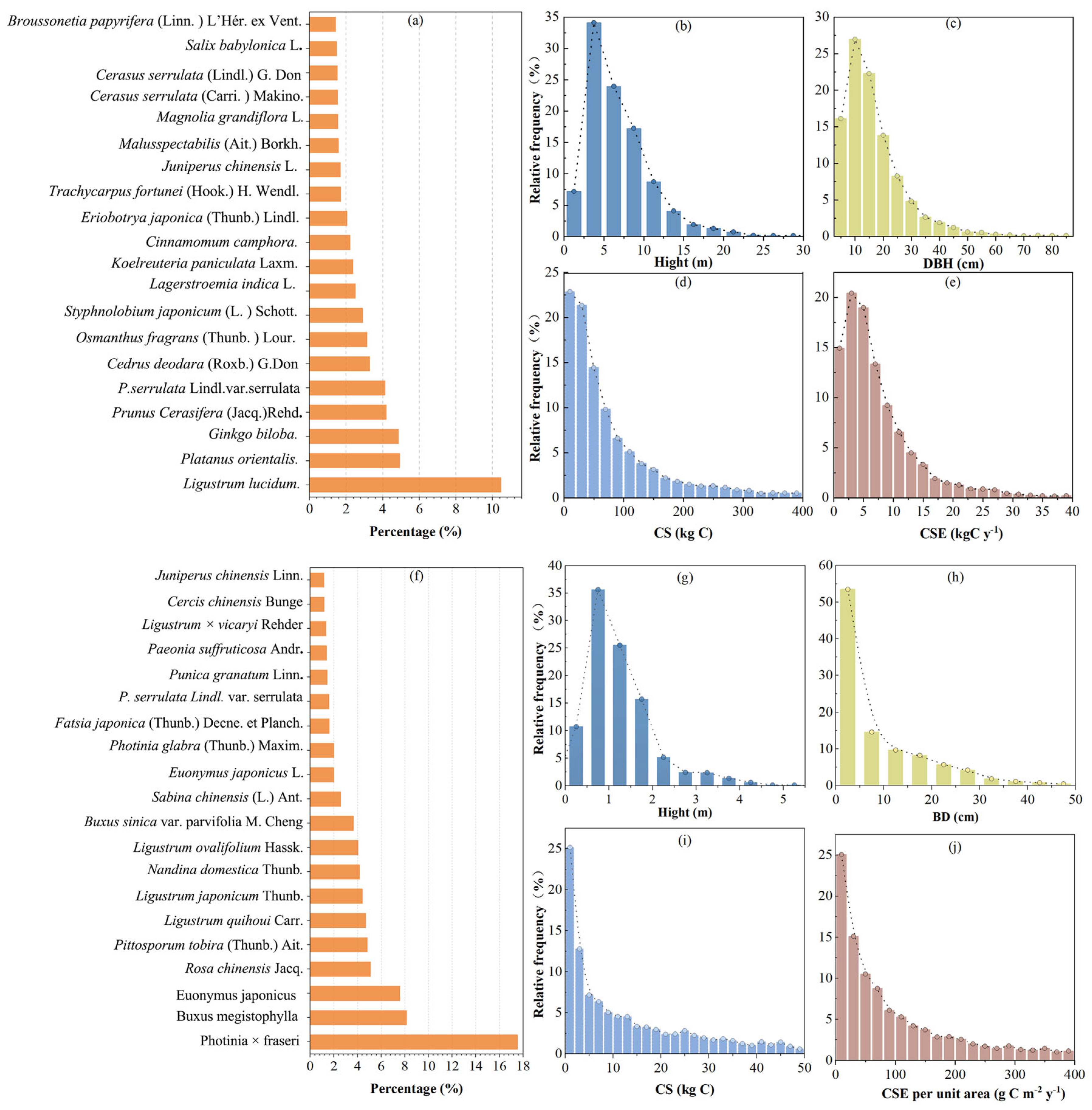
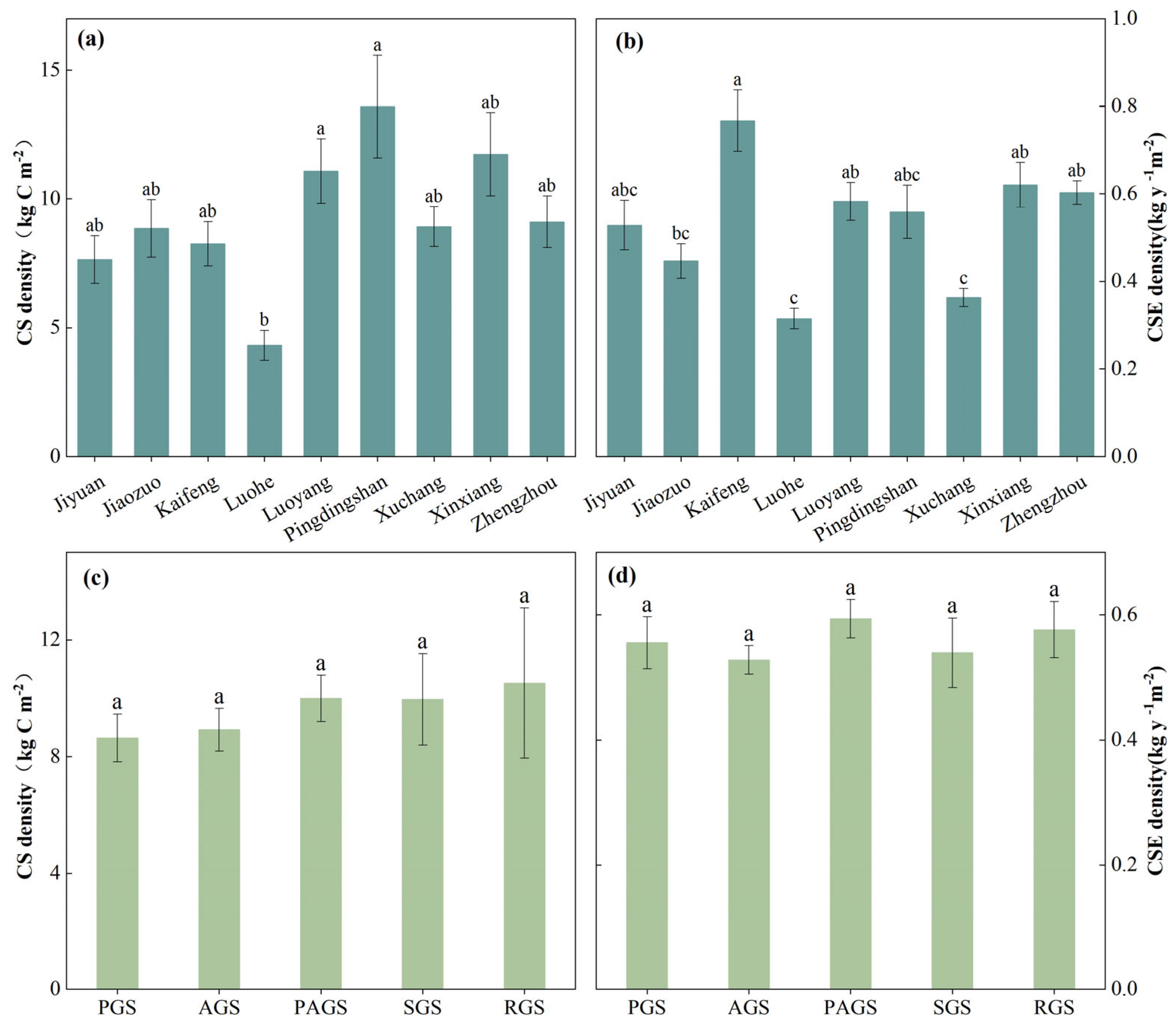
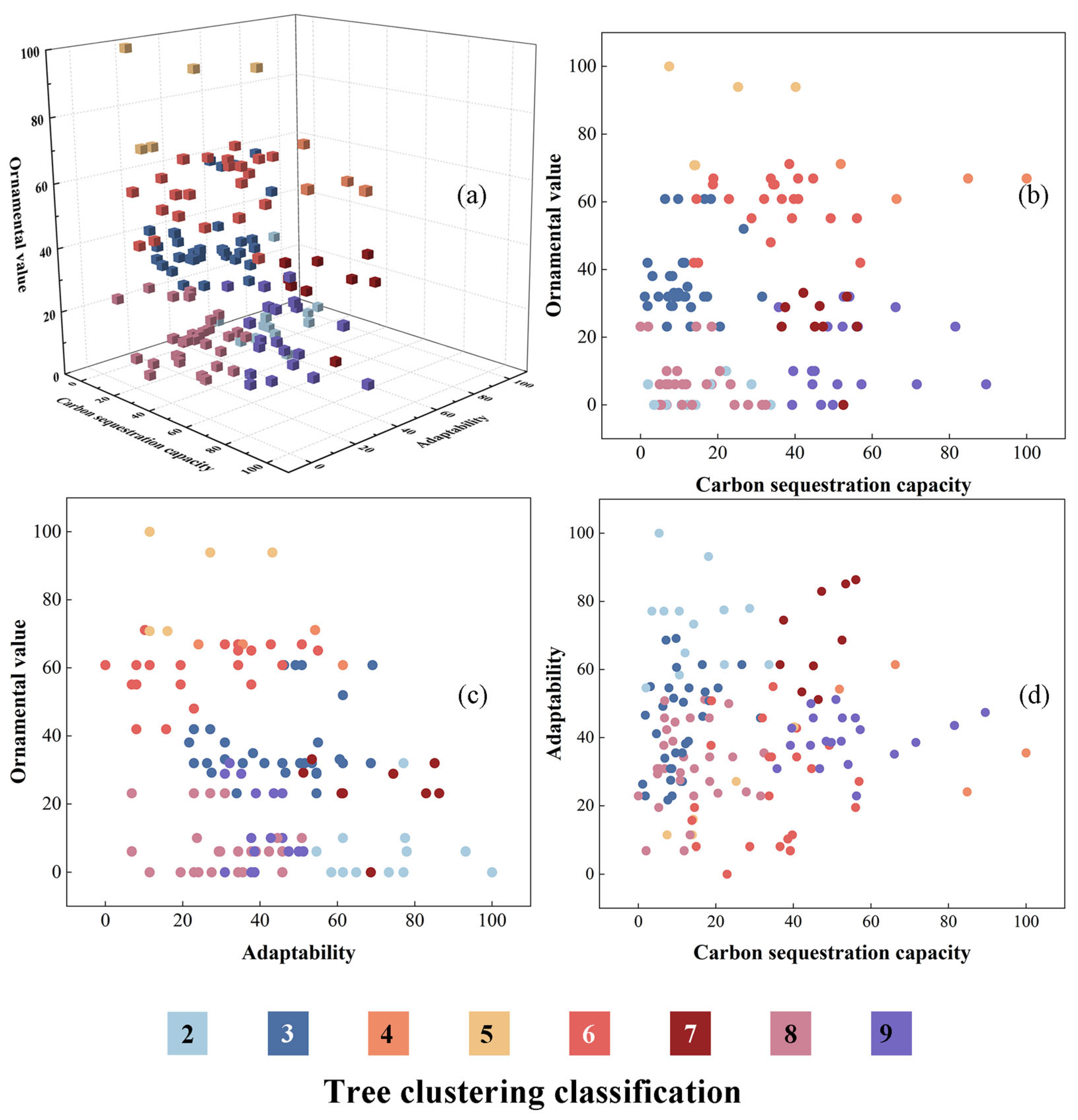
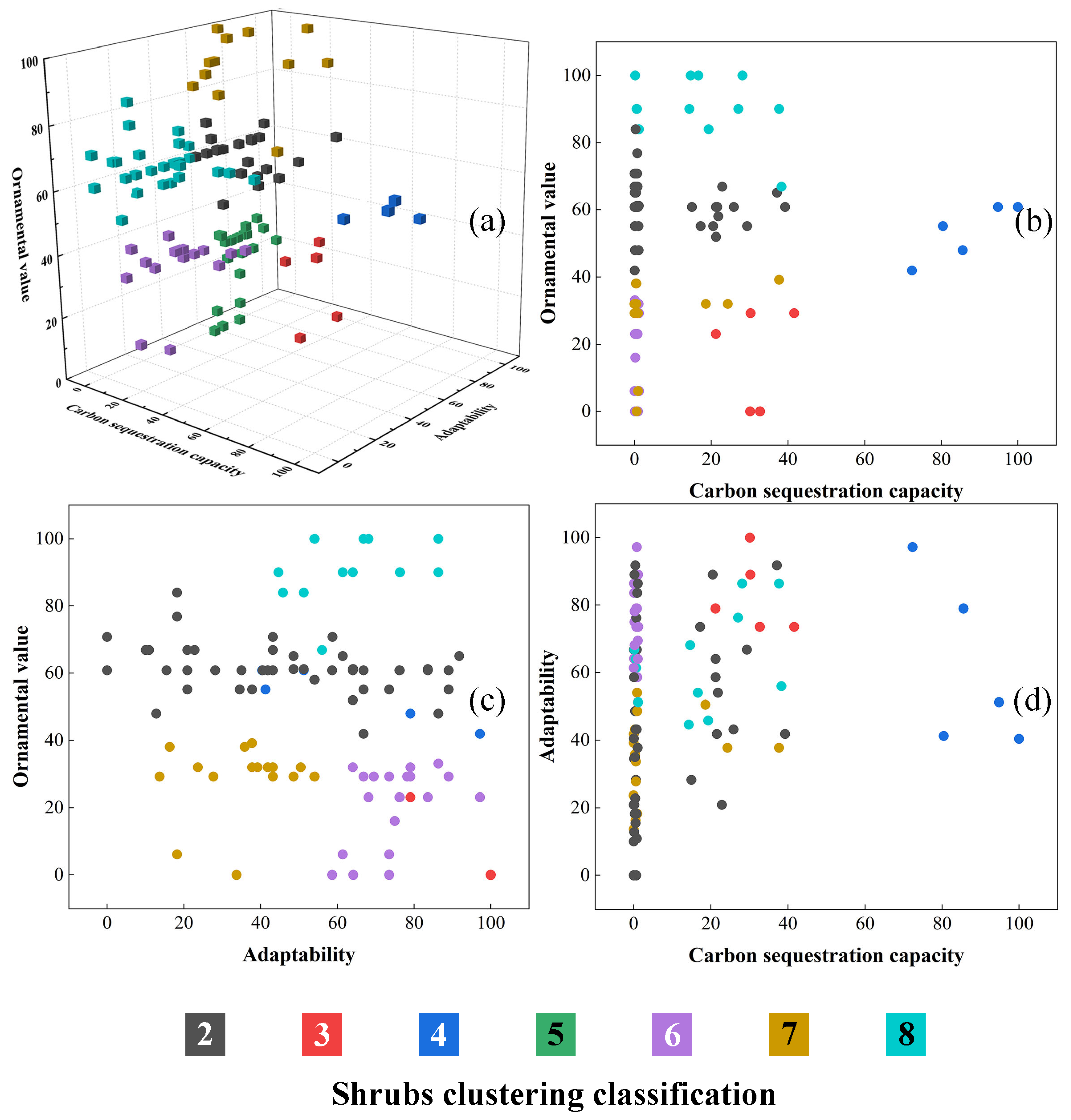
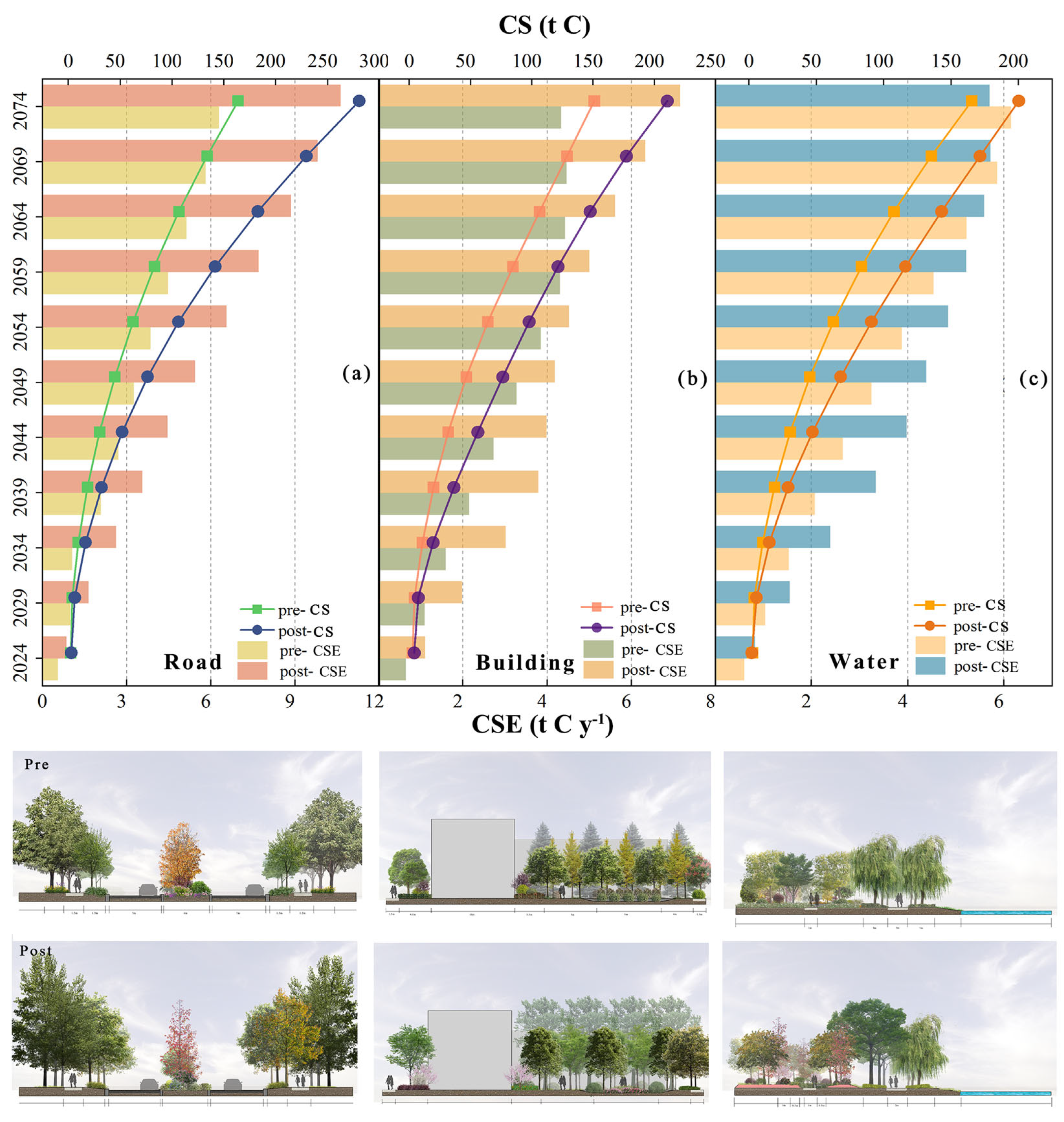
| City | PGS | PAGS | AGS | SGS | RGS | Total |
|---|---|---|---|---|---|---|
| Jiyuan | 9 | 5 | 9 | 4 | 3 | 30 |
| Jiaozuo | 14 | 9 | 26 | 4 | 6 | 59 |
| Kaifeng | 19 | 20 | 44 | 4 | 6 | 93 |
| Luoyang | 35 | 29 | 47 | 26 | 11 | 148 |
| Luohe | 14 | 12 | 28 | 8 | 12 | 74 |
| Pingdingshan | 35 | 29 | 47 | 26 | 8 | 58 |
| XuChang | 20 | 19 | 45 | 4 | 10 | 98 |
| Xinxiang | 18 | 8 | 26 | 7 | 6 | 65 |
| Zhengzhou | 60 | 67 | 166 | 32 | 24 | 349 |
| City | CS (kg C m−2) | CSE (kg C m−2 y−1) | CS (kg C m−2) | CSE (kg C m−2 y−1) | Source | |
|---|---|---|---|---|---|---|
| ZAM, CN | 9.32 | 0.55 | Zhengzhou, CN | 8.60 | 0.60 | This study |
| Luoyang, CN | 10.59 | 0.58 | Kaifeng, CN | 6.81 | 0.76 | This study |
| Pingdingshan, CN | 12.94 | 0.55 | Xinxiang, CN | 11.22 | 0.61 | This study |
| Luohe, CN | 4.11 | 0.31 | Xuchang, CN | 8.56 | 0.36 | This study |
| Jiaozuo, CN | 8.39 | 0.44 | Jiyuan, CN | 6.46 | 0.52 | This study |
| Henan, CN | 6.38 | China | 2.1 | 0.21 | [15,32] | |
| Barcelona, Spain | 1.12 | Florida, FL, USA | 10.70 | [27,29] | ||
| Michigan, USA | 14.20 | [31] | ||||
| Hartford, CT, USA | 10.89 | 0.33 | Lincoln, NE, USA | 10.64 | 1.74 | [30] |
| Moorestown, NJ, USA | 9.95 | 0.93 | Morgantown, WV, USA | 9.52 | 1.16 | [30] |
| New York, NY, USA | 7.33 | 1.10 | Omaha, NE, USA | 14.14 | 2.29 | [30] |
| Roanoke, VA, USA | 9.20 | 1.33 | San Francisco, CA, USA | 9.18 | 2.25 | [30] |
| Scranton, PA, USA | 9.24 | 1.28 | [30] |
Disclaimer/Publisher’s Note: The statements, opinions and data contained in all publications are solely those of the individual author(s) and contributor(s) and not of MDPI and/or the editor(s). MDPI and/or the editor(s) disclaim responsibility for any injury to people or property resulting from any ideas, methods, instructions or products referred to in the content. |
© 2025 by the authors. Licensee MDPI, Basel, Switzerland. This article is an open access article distributed under the terms and conditions of the Creative Commons Attribution (CC BY) license (https://creativecommons.org/licenses/by/4.0/).
Share and Cite
Ren, Q.; Zhang, L.; Yang, Z.; Zhang, M.; Wei, M.; Zhang, H.; Li, A.; Shi, R.; Song, P.; Ge, S. Multi-Criteria Plant Clustering for Carbon-Centric Urban Forestry: Enhancing Sequestration Potential Through Adaptive Species Selection in the Zhengzhou Metropolitan Area, China. Forests 2025, 16, 536. https://doi.org/10.3390/f16030536
Ren Q, Zhang L, Yang Z, Zhang M, Wei M, Zhang H, Li A, Shi R, Song P, Ge S. Multi-Criteria Plant Clustering for Carbon-Centric Urban Forestry: Enhancing Sequestration Potential Through Adaptive Species Selection in the Zhengzhou Metropolitan Area, China. Forests. 2025; 16(3):536. https://doi.org/10.3390/f16030536
Chicago/Turabian StyleRen, Qiutan, Lingling Zhang, Zhilan Yang, Mengting Zhang, Mengqi Wei, Honglin Zhang, Ang Li, Rong Shi, Peihao Song, and Shidong Ge. 2025. "Multi-Criteria Plant Clustering for Carbon-Centric Urban Forestry: Enhancing Sequestration Potential Through Adaptive Species Selection in the Zhengzhou Metropolitan Area, China" Forests 16, no. 3: 536. https://doi.org/10.3390/f16030536
APA StyleRen, Q., Zhang, L., Yang, Z., Zhang, M., Wei, M., Zhang, H., Li, A., Shi, R., Song, P., & Ge, S. (2025). Multi-Criteria Plant Clustering for Carbon-Centric Urban Forestry: Enhancing Sequestration Potential Through Adaptive Species Selection in the Zhengzhou Metropolitan Area, China. Forests, 16(3), 536. https://doi.org/10.3390/f16030536






